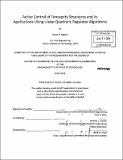Active control of tensegrity structures and its applications using Linear Quadratic Regulator algorithms
Author(s)
Nelson, Karen E. (Karen Elizabeth), M. Eng. Massachusetts Institute of Technology
DownloadFull printable version (10.76Mb)
Other Contributors
Massachusetts Institute of Technology. Dept. of Civil and Environmental Engineering.
Advisor
Jerome J. Connor.
Terms of use
Metadata
Show full item recordAbstract
The concept of responsive architecture has inspired the idea structures which are adaptable and change in order to better fit the user. This idea can be extended to structural engineering with the implementing of structures which change to better take on their external loading. The following text explores the utilization of active control for tensegrity systems in order to achieve an adaptable structure. To start, a background of the physical characteristics of these structures is given along with the methods which are used to find their form. Next, the different methods which have been previously used to achieve active control in tensegrity are reviewed as well as the objectives they intended to achieve. From there, the Linear Quadratic Regulator (LQR) algorithm is introduced as a possible method to be used in designing active control. A planar tensegrity beam is described, whose form was found by the force density method. A simulation is then conducted, which applies the LQR algorithm to this structure for the purposes of active control. This simulation served both to demonstrate the force density and LQR methods, as well as to study how different control parameters and actuator placements effects the efficiency of the control. This text concludes with a discussion of the results of this simulation.
Description
Thesis (M. Eng.)--Massachusetts Institute of Technology, Dept. of Civil and Environmental Engineering, 2011. Cataloged from PDF version of thesis. Includes bibliographical references (p. 61-62).
Date issued
2011Department
Massachusetts Institute of Technology. Department of Civil and Environmental EngineeringPublisher
Massachusetts Institute of Technology
Keywords
Civil and Environmental Engineering.